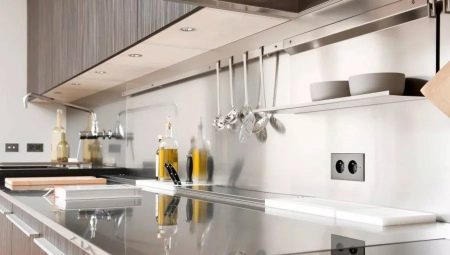It is impossible to imagine a modern kitchen without a large number of household appliances. She needs electricity, respectively, it is necessary to think about how to place a sufficient number of outlets so that they do not get out of the overall design and look appropriate. Currently, sockets are often placed on an apron. We will talk about the features and subtleties of installing outlets where food is cooked in our article.
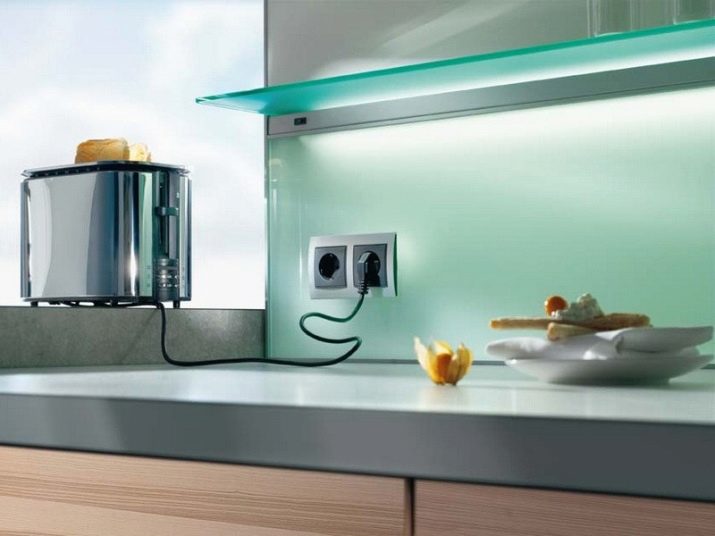
How to determine the quantity?
As for the number of outlets, a universal answer to this question does not exist. It all depends on how spacious the kitchen is, and how much household appliances are on it. However, experts recommend placing on an apron at least 3 outlets. You can mount nests of 2 or 3 pieces in different places.
The consumer must take into account that appliances such as stove, hob, oven, sink and hood must have independent sockets. As for the rest, several devices having a small power can be connected to one power supply.
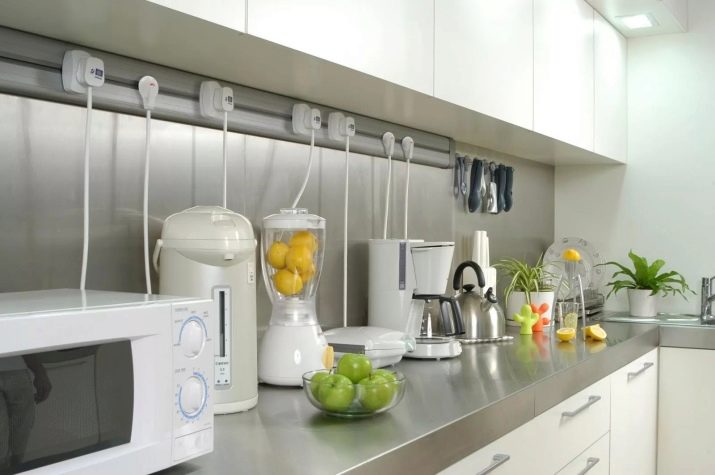
Height
Sockets are recommended to be placed at a distance of 10-30 centimeters from the countertop. This is a kind of standard for height. If possible, it is better to stay at higher rates. This will be very convenient when dishes are placed on the table or products are placed on it that block access to the outlet located too low.
There are some rules that must be followed during installation. For example, sockets designed for small kitchen appliances should be 1.1-1.4 meters from the floor.If illumination is provided, the power sources for it are 20 centimeters from the countertop. Sockets for hoods are located 50-60 centimeters from the cabinets.
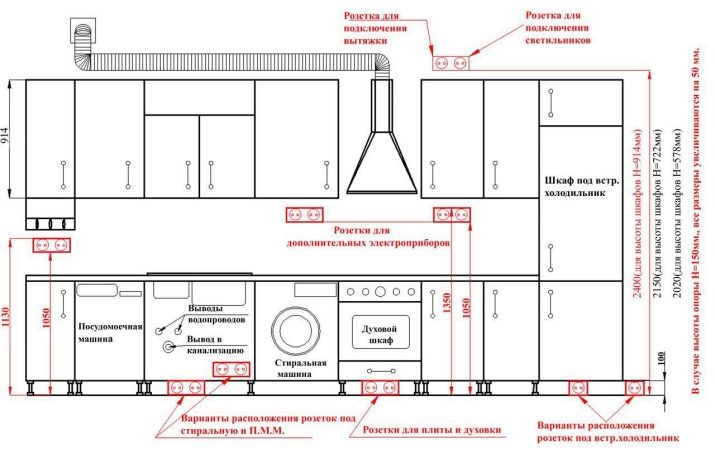
Installation Rules
The first thing you should pay attention to during installation is compliance with safety precautions when working with electricity. A device that plugs into an outlet need to be placed at a distance of no more than 1.5 meters about it. The power supply itself is installed at a height of 1 to 1.5 meters from the floor. It must be ensured that all contacts and wires are impervious to water. For the same reasons, do not place outlets in the sink area and near the hob.
As for the installation procedure itself, it consists of several stages. The installation can not be called too complicated technically, however, there are subtleties that must be taken into account in the process. An untrained person should not assume such a mission.
It is better to entrust the work with electricity to professionals if there is no solid self-confidence.
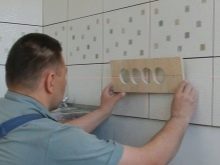


It should be noted that overhead sockets are most easily installed. In the case of them, it is often not necessary to shatter the walls under the wires. Such structures can be installed on top of the coating, while maintaining its integrity. In addition, such power sources have an affordable price. If you want to hide the sockets, you can use special hidden options.
This is a fairly new trend, however, is increasingly appearing on store shelves. Such power sources are points hidden under a special mechanism that opens them when pressed. When the sockets are closed, they are practically invisible. On top is a cover that protects against ingress of dirt and water.
Choosing this option, you need to carefully study this issue. The fact is that nominal indicators are a significant drawback.
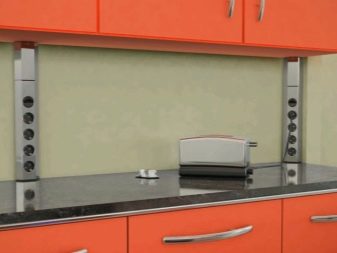
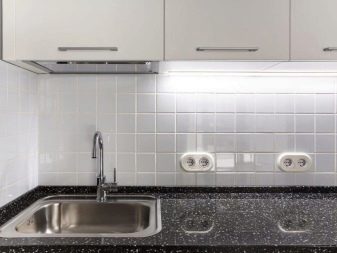
The current value of such outlets in the vast majority is 6A, which is absolutely not suitable for powerful equipment. In the kitchen, it is recommended to use elements from 10A. If this nuance is not scary, you should choose models made in a steel case.
Common mistakes
For those who are not experienced in installing power supplies, it is important to be aware of the most common mistakes. Note the main ones. There is a possibility that the number of installed outlets will not correspond to real needs. This can happen because new electrical appliances are purchased, respectively, more power points are required.
Installation should be done before the kitchen is installed. Do not forget about piercing the strobes, if necessary. The mistake is to install the outlet for the hood where it will be located.
It is forbidden to place food points in the immediate vicinity of a stove or kitchen sink. Models must be waterproof. Also, the size of the plinth on the work surface should not be taken into account. You can make a mistake in the wiring section.
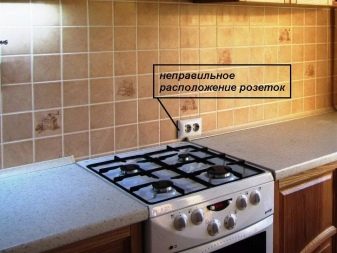

How to install?
When the layout of the power sources is ready, it is necessary to directly mark the surface of the apron. After that, the holes are prepared. How exactly this is done depends on what material the apron is made of. Most often, it’s enough to simply drill niches. At this stage, you must ensure that the pattern is not disturbed.. If the apron is made of glass, you will not be able to carry out the work yourself. Measurements should be made, which are then transferred to the manufacturer preparing the apron. This is the only option to make holes for sockets on a glass cloth.
The puncher hollows out a place under the outlet. If it is supposed to be installed in a place where there is already a power source, the previous version is dismantled.A distribution box is installed in the indicated area. Outlets are placed in the finished sockets, their connections are twisted, fastened and insulated. These manipulations are necessary in order to eliminate overheating during operation.
We must not forget that the phase and zero wires must be wired.
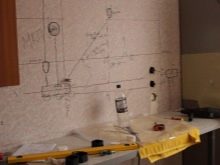
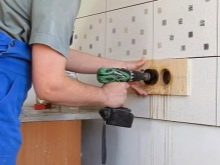
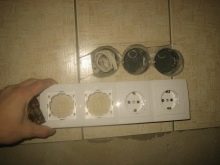
Installation process
As for the installation process itself, proceed as follows. First of all, the room where the work is carried out is required to be de-energized. After that, an apron is attached to the wall with prepared holes and wiring. Next, you need to install outlet boxes. The wiring is placed in the gate and fixed there.
In the next step, the outlet must be connected to the wiring. In the course of work, it will be necessary to ensure that the wires are connected both to the outlet and to the power distribution box. Next, the connections are checked, and if there are no comments, the strobes must be repaired with a building compound, on top of which the putty is applied. At the final stage, the sockets themselves are screwed on. Electricity is supplied to the room, and the functionality of the power sources is checked.
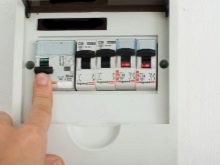
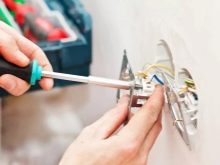
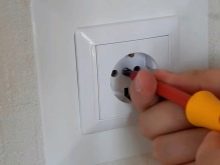
A master class on installing sockets on a kitchen apron is waiting for you next.
